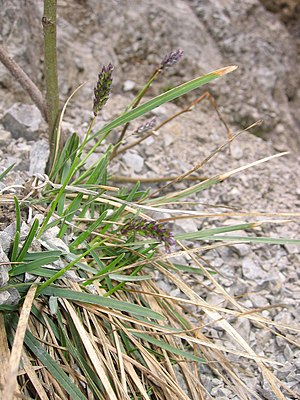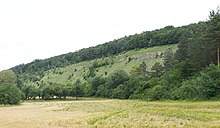Lime blue grass
| Lime blue grass | ||||||||||||
|---|---|---|---|---|---|---|---|---|---|---|---|---|

Lime blue grass ( Sesleria caerulea ) |
||||||||||||
| Systematics | ||||||||||||
|
||||||||||||
| Scientific name | ||||||||||||
| Sesleria caerulea | ||||||||||||
| ( L. ) Ard. |
The sesleria albicans ( Sesleria caerulea ) or ordinary blue grass is a plant from the genus of the blue grasses ( Sesleria ) within the family of grasses (Poaceae).
description
Appearance and leaf
The lime blue grass is a perennial, herbaceous plant and reaches heights of 10 to 40 centimeters. This dense, cushion-forming grass forms numerous renewal shoots that grow up inside the leaf sheaths. The stalks are only leafed in the lower part.
The leaf sheaths are glabrous, the lower ones can also be finely hairy and almost closed up to the top. The ligula is a membrane with a length of 0.2 to 0.5 millimeters. The bald leaf blades are flat-spread or folded up with a length of 10 to 25 centimeters and a width of 2.5 to 3 millimeters.
Generative characteristics
The flowering period extends from April to May. The panicle inflorescence is 10 to 30 millimeters long and 4 to 10 millimeters wide and is oblong-egg-shaped. The 4.5 to 7 millimeter long spikelets contain two to three flowers.
The number of chromosomes is 2n = 28.
Occurrence

The lime blue grass is common in Europe.
In Germany , the limestone blue grass is widespread in the Alps and pre-Alps . In the German low mountain range there are deposits from the Ahr valley to eastern Westphalia , to the northern Harz foreland and the edge heights of the Thuringian basin and to the Hainleite .
In Austria , this species occurs frequently in all federal states from the colline to subalpine altitude . In the Allgäu Alps in Bavaria, it rises between Kratzerjoch and Mädelegabel up to 2300 meters above sea level.
As a location, this limestone plant prefers stony dry grass , rocky grass and grassland , but it also occurs in dry and shallow forests, especially pine forests .
The lime blue grass is considered to be an indicator of leanness, a lime indicator, a pioneer plant and a debris dam . Sesleria caerulea is the characteristic species of the blue grass heap (Polygalo amarae-Seslerietum albicantis) and the blue grass grass (Seslerion albicantis). In high altitudes the species mostly thrives in societies of the order Seslerietalia, in lower altitudes it also occurs in those of the Festuco-Brometea class, the Erico-Pinion group or the Cephalanthero-Fagenion sub-group.
Systematics
The first publication for Sesleria caerulea took place in 1753 under the name ( Basionym ) Cynosurus caeruleus by Carl von Linné . The new combination to Sesleria caerulea (L.) Ard. was published by Pietro Arduino in 1764 . Other synonyms for Sesleria caerulea (L.) Ard. are for example: Sesleria albicans Schult. , Sesleria calcarea (Pers.) Opiz , Sesleria deyliana Á.Löve & D.Löve , Sesleria varia (Jacq.) Wettst. , Sesleria calcarea subsp. varia Jacq. , Sesleria caerulea subsp. calcarea (Čelak.) Hegi , Sesleria caerulea subsp. varia (Jacq.) Hayek .
Due to an incorrect lectotyping of the first publication by Linnaeus, another species, the bog blue grass ( Sesleria uliginosa Opiz ), was called Sesleria caerulea at times .
Subspecies of Sesleria caerulea are:
- Sesleria caerulea subsp. angustifolia (Hack. & Beck) Jogan
- Sesleria caerulea (L.) Ard. subsp. caerulea
Individual evidence
- ↑ a b c d e f Benito Valdés, Hildemar Wolfgang Scholz with the collaboration of Eckhard von Raab-Straube, Gerald Parolly, 2009: Poaceae (pro parte majore) : data sheet at The Euro + Med PlantBase - the information resource for Euro-Mediterranean plant diversity , last accessed on September 27, 2015
- ↑ a b Erich Oberdorfer : Plant-sociological excursion flora for Germany and neighboring areas . With the collaboration of Angelika Schwabe and Theo Müller. 8th, heavily revised and expanded edition. Eugen Ulmer, Stuttgart (Hohenheim) 2001, ISBN 3-8001-3131-5 , pp. 229 .
- ↑ Erhard Dörr, Wolfgang Lippert : Flora of the Allgäu and its surroundings. Volume 1, IHW, Eching 2001, ISBN 3-930167-50-6 , p. 174.
literature
- Manfred A. Fischer, Wolfgang Adler, Karl Oswald: Excursion flora for Austria, Liechtenstein and South Tyrol . 2nd, improved and enlarged edition. State of Upper Austria, Biology Center of the Upper Austrian State Museums, Linz 2005, ISBN 3-85474-140-5 .
- Hans Joachim Conert: Parey's grass book. Recognize and determine the grasses of Germany . Parey, Berlin 2000, ISBN 3-8263-3327-6 .
Web links
- Sesleria caerulea (L.) Ard., Blue-lime grass. In: FloraWeb.de.
- Lime blue grass . In: BiolFlor, the database of biological-ecological characteristics of the flora of Germany.
- Profile and distribution map for Bavaria . In: Botanical Information Hub of Bavaria .
- Sesleria caerulea (L.) Ard. In: Info Flora , the national data and information center for Swiss flora . Retrieved September 27, 2015.
- Distribution in the northern hemisphere according to: Eric Hultén , Magnus Fries: Atlas of North European vascular plants 1986, ISBN 3-87429-263-0 .
- Thomas Meyer: Data sheet with identification key and photos at Flora-de: Flora von Deutschland (old name of the website: Flowers in Swabia )




